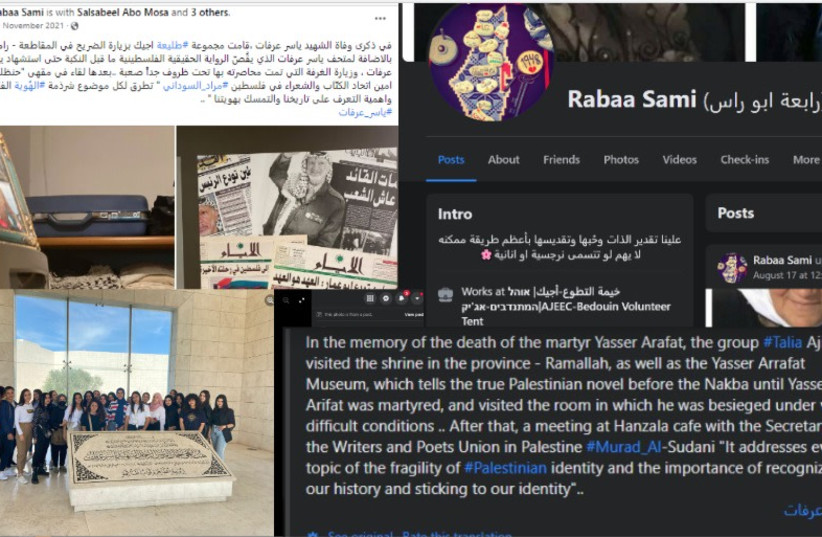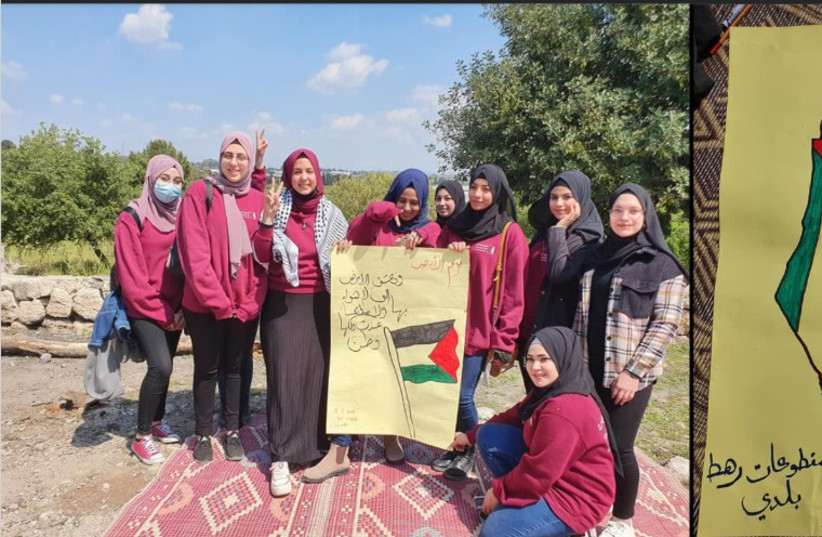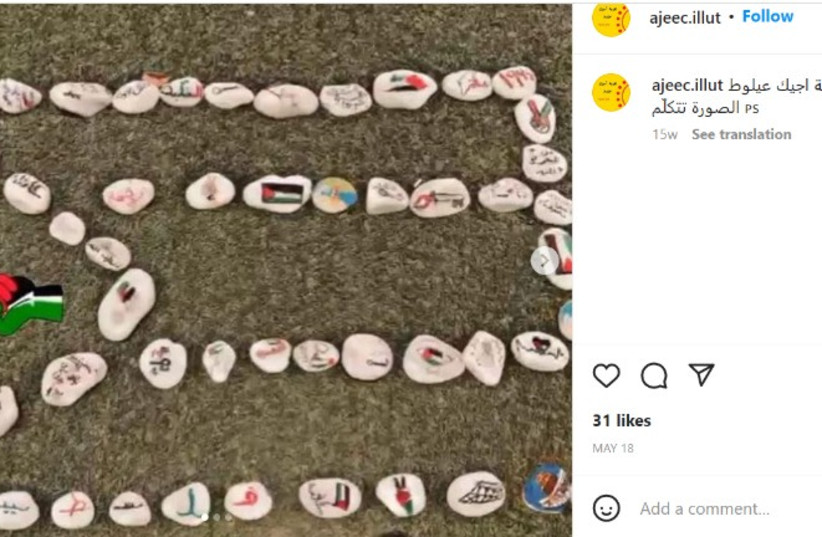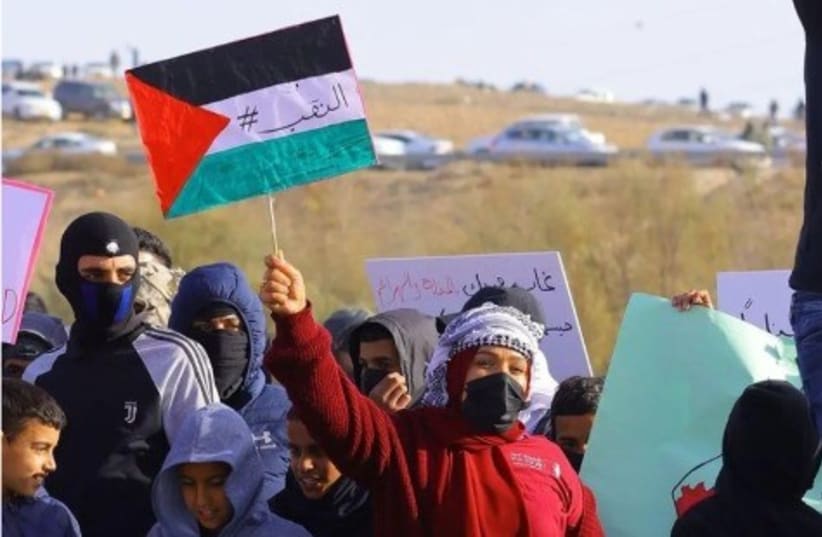As one of the largest Israeli-Arab groups focused on education, AJEEC also has its challenges.
One of them is the debate about teaching Palestinian nationalist narratives to Israeli-Arab citizens with government funding.
The Jerusalem Post found on social media almost two dozen instances of Palestinian nationalism and Land Day and Nakba Day commemorations by the movement’s youth group and other programs. One of the most contentious posts, which AJEEC opened a review into, was a post by an employee claiming participants in its gap-year program visited former Palestinian leader Yasser Arafat’s tomb.
“The AJEEC organization would never organize a visit to the grave of Arafat in Ramallah,” said a representative of Arab-Jewish Center for Empowerment, Equality, and Cooperation – Negev Institute for Strategies of Peace and Economic Development (AJEEC-NISPED). “We’re checking why someone presented the visit as part of the organization’s activities and if it is a real post at all.”
“The AJEEC organization would never organize a visit to the grave of Arafat in Ramallah. We’re checking why someone presented the visit as part of the organization’s activities and if it is a real post at all.”
AJEEC-NISPED
Visiting the tomb and museum of the "martyr" Yasser Arafat
Rabaa Sami, who identifies herself on social media as an employee of AJEEC’s Bedouin Volunteer Tent, posted on Facebook in November 2021 how the Taliyah volunteer program visited the tomb “in memory of the death of the martyr Yasser Arafat.”


The group also visited the Arafat Museum, which claims to tell “the true Palestinian story before the Nakba until Yasser Arafat was martyred.”
The group met with a representative of a Palestinian writers’ union who explained to them how “it addresses every topic of the vulnerability of Palestinian identity and the importance of recognizing our history and sticking to our identity.”
The post was deleted soon after The Jerusalem Post began making inquiries about the content.
AJEEC chairman Kher Albaz explained that the organization didn’t receive a request for such a trip, and it wouldn’t have been approved if it had been. For insurance purposes, they don’t send groups over the Green Line, and they have detailed budgets from the Education Ministry for activities.
“Every activity like this [a trip] is approved by the Education Ministry to the last detail,” Albaz said.


Palestinian nationalism in the youth group
CONTENT PERTAINING to Palestinian nationalism, often during commemorations of Land Day and Nakba Day, was found on accounts related to eight youth group branches, the Bedouin Volunteer Tent, Sabil Leadership Institute, and the main organization’s account.
Land Day, a Palestinian holiday held annually on March 30, commemorates the Israeli government’s expropriation of Arab-owned land in Galilee in 1976, which led to riots and confrontations with the IDF and police.
Nakba Day is observed on May 15, and is a memorial day for the Nakba – or “catastrophe,” used to describe the turmoil and displacement of Arabs in the wake of Israel’s War of Independence. AJEEC has been holding Land Day and Nakba Day ceremonies, marches and events since at least 2012, their Internet footprint shows.
While the subject is far from the bulk of AJEEC’s programming, many of the social media posts on Land Day events show emphasis on Palestinian identity. An April 21 post by the Sabil Leadership Institute showed a flyer for Land Day with the organization’s logo, barbed wire and a Palestinian flag. The same year, the Qalanswa branch of the youth group shared their event, which saw them raising a poster with the entire territory of Israel and the West Bank, from the river to the sea, colored like the Palestinian flag.
The Kafr Kassem youth group posted in 2018 about their Nakba memorial event. It featured a map of Israel with important dates on it besides the Nakba, including the Naksa (“Day of the Setback”; the term Palestinians use to describe the Six Day War) and the Second Intifada. A 2016 Nakba Day march organized by the Volunteer Tent was advertised with themes of a Palestinian return.


The Post’s review also found Palestinian “resistance” imagery and rhetoric. One youth branch posted an image in March with a protester with an AJEEC shirt waving a Palestinian flag with “Negev” written in Arabic. A May post on Instagram by the Ilut youth group features a revolutionary fist with stones painted with Palestinian icons.
Part of a process of radicalization and education?
AJEEC Co-CEO Ariel Dloomy said that while he didn’t like some of the content, and that he could understand how such content could cause feelings of discomfort and fear among Israeli Jews, the materials should be understood within AJEEC’s processes of deradicalization and socialization.
“We don’t receive [youths] as a blank page; everyone is influenced by his own background,” said Albaz. AJEEC accepts that some of its youth will be coming to them with controversial ideas.
In order to achieve its objectives of creating a society in which “everyone is accepted” and its students are successful and law-abiding, they need to start a dialogue with the youths from their own axioms, Dloomy argued. Being in a safe place allows the youth to be open to new ideas.
“If I want to change this reality, I need to start where people are,” he said. “It is an in-depth educational concept – so that this [Palestinian] flag remains a concept, that it remains as something spoken about and not as something else.”
Albaz said that Land and Nakba Day programming is part of this process, and both Arab and Jewish youth who come to AJEEC have preconceived notions about Land Day. They learn about the topics, and alongside them learn about Independence Day and Holocaust Remembrance Day – even meeting with Holocaust survivors. For many, it is their first encounter with Jewish holidays and Israeli narratives.
“Our Facebook page has endless posts about joint activities between Arabs and Jews,” said Dloomy, adding that the few posts found by the Post don’t reflect the majority of AJEEC’s activities. Indeed, reviews of their platforms show mostly typical youth group activities, content such as COVID-19 awareness programs for the Arab sector, and campaigning against crime and domestic violence in the community.
Albaz argued that the best measure of AJEEC’s success was how many of its students move on to academics, with 10% of participants undertaking higher education each year. Moreover, according to Dloomy, “No AJEEC alumnus – I can say also in the past and the future – would ever lift a stone and be involved in illegal activity because we are undertaking a serious and deep process of anti-radicalization.”
